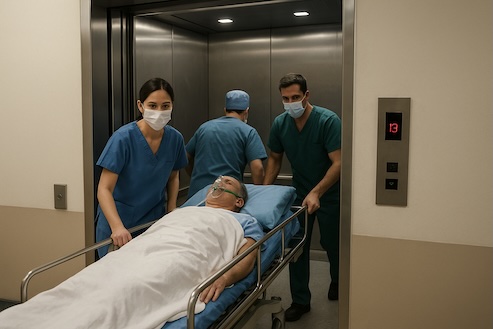A tertiary hospital in North China, which receives over 8000 patients per day, is in crisis due to frequent elevator malfunctions. The Japanese brand elevators initially purchased by the hospital are suitable for small and medium-sized hospitals, but they are difficult to meet the needs of domestic tertiary hospitals. A critically ill patient was trapped in an elevator for 23 minutes and missed the golden treatment time, unfortunately passing away, causing the hospital's reputation to plummet.

Design and Load Defects
To save costs, the hospital chose an elevator with a load capacity of 1600kg, but in actual use, stretchers and medical staff are often overloaded. During an outbreak of an infectious disease, the elevator was overloaded for a long time, and the overheating protection of the traction machine was activated. The entire building was shut down for 4 hours, and patients were forced to be manually lifted, exposing serious defects in equipment and logistics.
Maintain gaps
Although the contract requires a 30 minute on-site repair, it took 11 hours to fix a single malfunction. Nationwide, 78% of hospitals still adopt the "post repair reporting" model. The medical elevator should have a fault free time of 2000 hours, but in reality it only has 850 hours. The chaotic management of spare parts and the misuse of backup power sources have further weakened reliability.
Intelligent system transformation
The hospital subsequently introduced an AI elevator management system. Sensors and cameras can recognize equipment such as stretchers and wheelchairs, automatically prioritize emergency transportation, and play guidance videos, notify wards, and share arrival times through the "triple response mechanism". After application in a certain cancer hospital, the patient transfer time was reduced from 18 minutes to 6 minutes.
Smart medical terminal
The 'emergency surgery mode' allows the elevator to automatically turn on the shadowless light and emergency interface when there is a power outage, increasing the success rate of emergency treatment from 32% to 89%. The elevator screen not only displays the floor, but also transmits medical records and can adjust the temperature to surgical standards in advance.
Results and Impact
Patient satisfaction increased from 68 points to 91 points, and the success rate of emergency treatment increased by 17%. Although the procurement cost of smart elevators is 50% higher, annual maintenance expenses have decreased by 76%, and related medical disputes have disappeared. In a city wide emergency drill, the elevator system of the hospital was the only medical unit that passed the "4-hour continuous operation without power" test and was awarded the national "Smart Hospital Construction Demonstration Unit".
